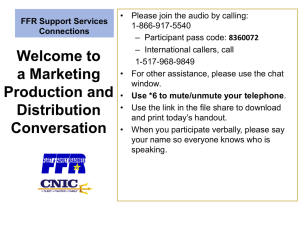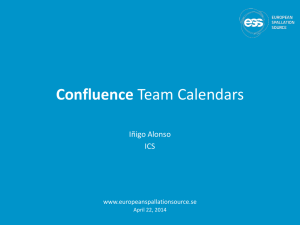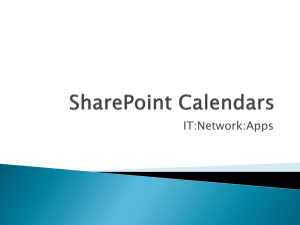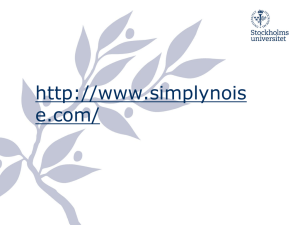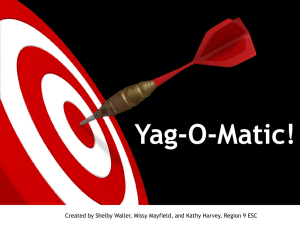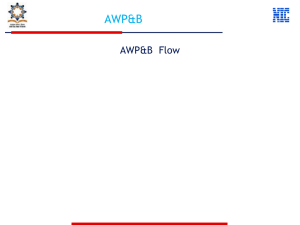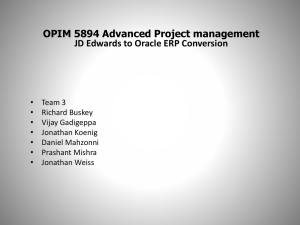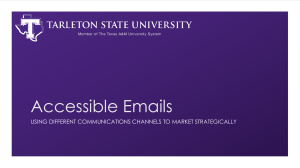PowerPoint - Lehigh University
advertisement
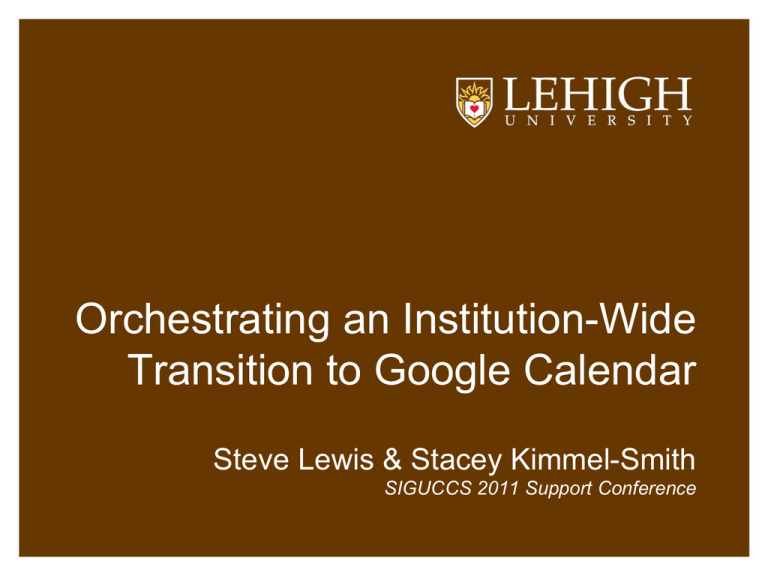
Orchestrating an Institution-Wide Transition to Google Calendar Steve Lewis & Stacey Kimmel-Smith SIGUCCS 2011 Support Conference Abstract Lehigh University utilized Oracle Calendar since 1999. Advanced customer expectations, rising licensing costs, and ever-increasing trouble reports led to an investigation of alternative calendaring products. Google Calendar was selected as the replacement calendaring system. This is our story… About Lehigh University • Bethlehem, Pennsylvania – 90 minutes from New York City • 6,900 students – 4,700 undergraduates – 2,200 graduate students • 660 faculty members • 1,000 support staff Library and technology support services integrated into one unit: Library & Technology Services (LTS) Brief History of Electronic Calendaring at Lehigh 1997 1998 1998 1999 Faculty and staff testing of Netscape Calendar begins Nearly 350 trial users Problem: Test server crashed, some data lost. Bigger problem: Trial users were using it with production-level expectations! Solution: Host on new server and subscribe to support. Another problem: Netscape lost the license to its underlying calendaring technology! Solution: License the software, known as Corporate Time, directly from Corporate Software & Technologies (CST) after considering alternative packages. Brief History of Electronic Calendaring at Lehigh 2000 2002 CST merges with Lexacom forming Steltor. 500 users at this time. Oracle buys Steltor and renames product Oracle Calendar. life is reasonably good for several years… 2008 Oracle prepares to discontinue Oracle Calendar in favor of their new Oracle Beehive collaboration suite. Problem: Expensive to license and difficult to host / administer. About Oracle Calendar • Desktop client • On-campus server • Web-based client had very limited subset of features • One calendar per user • Room / resource calendars available PDAs and Smartphones • Palm devices used as early as 1997 – Serial / USB sync to Oracle Calendar plugin to Palm Desktop • Palm Treo smartphone appears in 2003 – People like mobile e-mail. – Still no over-the-air (OTA) calendar sync since 2G connection was too slow and often failed. – Remained Lehigh’s recommended smartphone through 2008. 3G Comes Along… • BlackBerry Bold 9000 released as AT&T’s first 3G smartphone in 2008. – OTA calendar synchronization becomes reality using Nexthaus SyncJE • About a year later, Synthesis AG’s ToDo+Cal+Sync for iPhone available. – Allowed iPhone to OTA sync Limitations of Oracle Calendar (learned over a decade) • Cost – Partially subsidized by LTS, a per-user fee paid for each license issued. – License reuse not possible since deleting users deleted shared meeting data. – Well-funded departments could afford this while others could not. Fragmentation of the user base resulted; no common campus calendaring platform. Not used by students. Limitations of Oracle Calendar (learned over a decade) • PDA / Smartphone synchronization – Often failed, resulted in duplicated or missing calendars. • Customer expectations – Users not content with just one calendar – Web interface limitations unacceptable Initial testing of Google Calendar • Google Apps instance created in 2007 • LTS Client Services staff transitioned in 2008 • Athletics Department transitioned in 2009 – Very willing to participate since they had budget limitations allowing only a subset of their staff to use Oracle Calendar • Feedback was positive and LTS became very confident that Google Calendar was a suitable replacement for Oracle Calendar. Our Marketing Points • Oracle Calendar – – – – – Deprecated Not fully web-based Costly Fraught with PDA synchronization problems Closed system which did not allow interaction with others • Google Calendar – – – – Fully web-based Free of licensing costs More features Open system capable of interacting with anyone in the world Departmental Transitions • Departments transitioned one at a time over a six-month period. • Per-user transition process 1. 2. 3. 4. 5. 6. Export data from Oracle Calendar Cleanse data* Import into Google Calendar Set permissions Reconfigure PDAs Setup user backup* Cleansing Oracle Calendar Data • A straight export from Oracle Calendar to Google Calendar works for most events. • Repeating events, however, would not correctly synchronize to iOS devices. • Solution - Strip the following fields out of the exported data before importing to Google: – X-ORACLE-EVENTINSTANCE-GUID, X-ORACLE-EVENTTYPE, UID, RECURRENCE-ID, ORGANIZER, X-ORACLE-CLASS, CLASS, ATTENDEE, TRIGGER, ACTION, RDATE. Backing up Google Calendar • Google backs up data for their own purposes. – Their backups are not accessible to customers / subscribers. • Customers may accidently delete data or experience destructive failure of a PDA synchronization session. • Daily job on LTS server accesses Private URL and saves ICS data. Keeps working daily unless user explicitly resets Private URL. Backing up Google Calendar Client Training • Multiple training venues – Self-paced guides – Classroom led instruction – Deskside overviews • Let’s hear from Stacey Kimmel-Smith…


